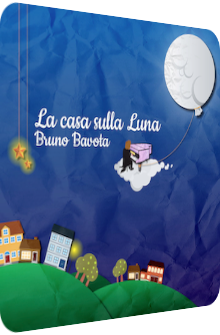
Bruno Bavota
La Casa Sulla Luna
2013
“Music decided to save my life, covering me with a huge, warm hug.” There is no better way to start this review than with these words of wisdom by Napoli-based pianist and composer Bruno Bavota, as these feelings of beatific gratitude are firmly embroidered in each and every of the artist’s ten compositions that are part of La Casa Sulla Luna (the house on the moon). Self-released on Bandcamp in February 2013 where it is available to purchase and fully streamable, the Italian artist’s sophomore album somewhat ignores its title by unleashing cavalcades of earthbound warmth and rays of sunlight. Every piece is a completely unprocessed piano arrangement and played on a Steinway D–274 grand piano, but on a few compositions, Bavota is joined by cellist Marco Pescosolido and violinist Paolo Sasso who transmute the formerly humblest yet most royal base frame into pieces of chamber music. Within the boundaries of La Casa Sulla Luna, willful eclecticism is definitely not what the pianist has in mind. The organic constructions feature wondrous melodies, beautiful overtones as well as shimmering lights. Certain moments of mystique, vacillation and tension are perceptible, but exalted and transfigured into mere undercurrents. They are never the leitmotif, nor do they degrade the happiness of a segue or whole piece. A work that can be poignantly described as neo-Classical Ambient, La Casa Sulla Luna is a euphonious moonstone. Read on to know more about the liminal dissonances, nostalgia particles and vast amount of mirth below.
The opener Amour could sport many possible physiognomies and clichés, but is actually a surprisingly vivid and effervescently cascading piano arrangement. It is naturally not surprising per se, for the exuberant sequence of chords and the in-flux glissando are perfectly transforming love-related euphoria and elation into music, it is just that the humble reviewer has encountered one too many love-related themes in the fields of Ambient and, well, Exotica, so that the joyously blithesome evocation of spirits illumined by glowing sunlight is almost atypical, for Bruno Bavota’s composition lacks the rose-tinted aura. But sunlight is not what the artist has in mind, at least not in regard to the overarching concept which is first embodied by L’uomo Che Rubò La Luna (the man who stole the moon), a slightly more lachrymose downtempo ballad with both an ashen luminescence and more melancholic interstices. That being said, it is only the micro-tonal mélange in tandem with the title that evoke a supernatural crime, as the chord progression itself is alloyed in contentment, culminating in a feeling of success during the song’s apex.
Il Dito Si Muove Sul Vetro Appannato (the finger moves on the misty glass) is a short suite of chamber music for piano, cello and violin, inspired by a line Sean Penn speaks in Paolo Sorrentino’s drama This Must Be The Place (2011). Bavota’s otherwise disconnected ode sees the superimposition of golden globs of piano keys, heart-breaking yet vibrant evening coils on Pescosolido's cello and the hatched incandescence of Sasso's floating violin cloudlets. The interdependence and flow of the piece are as important as the textural variety; the piano serves as the rhythm devices, then takes over the lead before it becomes enmeshed again with the mediating stringed instruments, evoking mutual understanding without neglecting a certain pressure and immediacy. There is even room for silence and long phases of afterglow in this piece. The following C’è un cinema laggiù (there’s a cinema over there) is closely tied to the cinematic nature of the whole album in general and the Sean Penn-inspired forerunner in particular, but at first reverses the dense embroidery of textures and is only based on Bavota’s sepia-toned undulation of the keys before the strings return and gyrate around the silkened motif. While Seguimi, Amore (follow me, love) revs up the already bucolic-uplifting aurora of the love-related opener and sees its own intrinsic scheme realized in a distinct piano arrangement, the fittingly dualistic Buongiorno, buonanotte – again solely carried by the piano in the first part, then ameliorated by violin and cello – is the saddest of all pieces; it may not be entirely lugubrious, but nonetheless somber, with the string-accentuated part emanating a dark rufescent warmth.
Bruno Bavota, unsurprisingly, remains close to the crepuscular timeframe, continuing the aural depiction of nocturnal hours with an archetypical Mediterranean night: Cielo Blu Notte (blue night sky) surprises with a dialog between the almost quirkily saltatory piano and cello. This eminently reactionary formation is as transparent as it is refreshing and playful, and thankfully not overused, for during the remaining runtime, the focus remains on the most majestic of all instruments. Il sole di Domenica (the Sunday sun) meanwhile prepares the listener for the return to iridescent daylight and spawns another stylistic variety. Shuttling between pressing sections and genteel segues, the piece later shifts its rhythm into 3/4 time and becomes a waltz of opalescence. Arrivederci Signora Luna then turns out to be the penultimate composition but thematic closer, comprising of strikingly golden, fully erbaceous tercets and fragile counterparts which inherit both the kind of sadness all goodbyes carry and the last bunch of multiplexed pale moonbeams. The actual apotheosis is of the spectral kind: Ghost Track is more of an appendix rather than a distinct part of the endemic moon-devoted suite. Despite its title, creepiness does never ensue. A clear cut piano arrangement coated in the same glowing light as the majority of La Casa Sulla Luna, it oscillates between benign phases of solemnity and contemplation, followed by exuberantly joyful sections of bliss, thus sharing enough attributes to be fully compatible with the overarching topic and style. The title might mirror the track's quasi-ostracized status, but Ghost Track remains a harmonious endpoint regardless.
With his sophomore album La Casa Sulla Luna, Bruna Bavota fathoms out the concentrated endeavor that is commonly called a concept album, although there are no histrionic or overly mightily cinematic protrusions and eruptions ever unleashed. The album factors out unwanted, potentially pernicious elements or subthemes and allows the listening subject to figuratively bathe in – or submerge into – moonlit and sun-covered locations. In preference to carving out wildly pompous pieces, Bavota’s driving factor is based on contentment, understanding and the well-known mantra “life is good,” here presented in a positively streamlined, plateau-like diorama. La Casa Sulla Luna is by no means based on complaisance or the wish to please the listener at all costs. And yet it probably achieves exactly that through its inviting atmosphere sans obstacles. Short-lived moments of comparably transparent hectic as found in constructions such as Il Dito Si Muove Sul Vetro Appannato showcase the ambition to interweave cinematic capsules into the ubiquitous state of amicability, but it remains to be seen whether – and if so, how – the composer will realize these possibly darker and gloomier strata in the future. For the time being, thankfulness, gratitude and the joy of living glow stupefyingly strong in La Casa Sulla Luna, an unexpected assessment in the context evoked by the track titles and the surrounding extra-musical times which inspire and alter an artist’s vision. Bruno Bavota has achieved a lot, with his performances at the Accidental Festival, the Royal Albert Hall and places as remote as Iceland being remarkable highlights, so the next step could be to find out whether the Neapolitan composer is equally able to envision and absorb darker forces or create convoluted arrangements. In the meantime, the solar and lunar beams of La Casa Sulla Luna gleam in technicolor, with the occasional sepia-toned nostalgia layering technique alleviating their luminosity.
Further listening and reading:
- You can purchase and fully stream the album at Bandcamp.
- Bruno Bavota’s Twitter account is @BrunoBavota.
Ambient Review 283: Bruno Bavota – La Casa Sulla Luna (2013). Originally published on Nov. 13, 2013 at AmbientExotica.com.
